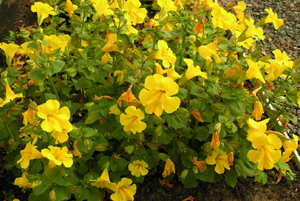Mimulus guttatus has been a model organism for studies in evolutionary biology, genetics, and ecology since the 1940s. The leaves are edible either raw or cooked.
Photo Credit: © Algirdas via Wikimedia Commons
Mimulus guttatus
Common Name: seep monkeyflower
Other Common Names: common monkeyflower
Plant Functional Group: Forb
Class > Order > Family: Magnoliopsida > Lamiales > Phrymaceae
What does the species look like?
This species is either an annual or perennial and is quite variable in form and size. It can reach heights between 2 and 150 centimeters, and the foliage and flowers can be either hairy or glabrous. The oval to rounded leaves are 4 to 125 millimeters long, often with shallow teeth along the leaf margins. There are generally greater than 5 flowers on each inflorescence. There are 5 unequal lobes (2 upper and 3 lower) on the yellow flowers, often with orange spots on the lower lip. The tubular flowers are 6 to 30 millimeters long. This species is generally bee pollinated.Mimulus guttatus is widespread and common in many geographic regions. It is found in wet places, such as along streams and seeps, and is generally terrestrial but occasionally is emergent or floating in mats. It is found at elevations less than 2500 meters.
Where is the species found?
States & Provinces
AB, AK, AZ, BC, CA, CO, CT, DE, ID, MI, MT, NB, ND, NE, NM, NT, NV, NY, OR, PA, SD, SK, UT, WA, WY, YT
Which phenophases should I observe?
Do you see...?
Leaves
Initial growth More...
Leaves More...
Flowers
Flowers or flower buds More...
How many flowers and flower buds are present? For species in which individual flowers are clustered in flower heads, spikes or catkins (inflorescences), simply estimate the number of flower heads, spikes or catkins and not the number of individual flowers.
Less than 3 3 to 10 11 to 100 101 to 1,000 More than 1,000
Open flowers More...
What percentage of all fresh flowers (buds plus unopened plus open) on the plant are open? For species in which individual flowers are clustered in flower heads, spikes or catkins (inflorescences), estimate the percentage of all individual flowers that are open.
Less than 5% 5-24% 25-49% 50-74% 75-94% 95% or more
Fruits
Fruits Mimulus guttatus , the fruit is a capsule, hidden within persistent and papery flower parts, that changes from green to tan or brown and splits open to expose the seeds. Do not include empty capsules that have already dropped all of their seeds.More...
How many fruits are present?
Less than 3 3 to 10 11 to 100 101 to 1,000 More than 1,000
Ripe fruits Mimulus guttatus , a fruit is considered ripe when it has turned tan or brown and papery and has split open to expose the seeds. Do not include empty capsules that have already dropped all of their seeds.More...
What percentage of all fruits (unripe plus ripe) on the plant are ripe?
Less than 5% 5-24% 25-49% 50-74% 75-94% 95% or more
Recent fruit or seed drop More...
How many mature fruits have dropped seeds or have completely dropped or been removed from the plant since your last visit?
Less than 3 3 to 10 11 to 100 101 to 1,000 More than 1,000
What do these phenophases look like?
There is currently no photoguide available for this species. If you'd like help us create one, use the guidance document and species template provided here . Then send it via email to education@usanpn.org when it is complete.
